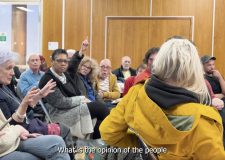New Sussex Town Planned
Plans have been put forward for 10,000 new homes to be built on the Sussex Countryside 10 miles north of Brighton.
Despite the promise of 10,000 new jobs, Mid Sussex District Council has declared their opposition to the scheme, put forward by Mayfield Market Towns. The company has stressed the idea of giving people choice, instead of the usual format of town ‘add-ons’ to existing settlements. In an official statement, Mayfield Market Towns said, “Rather than having continued add-ons to villages and towns in the area, they have a choice of providing it in a new settlement in the countryside which is detached from existing settlements.”
Perhaps the most important development, should the plans lead to fruition, would be the creation of three new primary schools. The necessity of these schools has not managed to sway residents of the area, who feel the plans for the 1000 acre site between Hurstpierpoint and Henfield as ridiculous. One resident said, “I think it’s a crazed idea, I’ve heard about it today and I cannot believe it.” This view echoes the belief that the scheme would destroy the countryside and put immense pressure on local services, some of which are long standing in the community.
If planning is approved, then the construction would begin in 2017 and would take an estimated 20 years to complete. This scenario follows on from prior decision making from the District Council regarding another housing development. A 230-home development in Lindfield was approved on Tuesday evening by the Council, despite strong protests from local villagers, who demanded that they would not be able to cope with the new infrastructure. A total of 69 affordable homes have been promised though this has not altered the mind-set of the campaigners, who in a recent protest said this was a ‘last chance to say no’.
The homes will be built between Lindfield and Walstead. The head of the protest campaign, John Ely, conceded defeat and was shocked that the 1,200 letters and the petition, signed by 800 residents sent to the council, led to nothing. “It was a very disappointing result”, he said. His opinion is shared with Gil Kennedy, vice-chairman of the Lindfield Preservation Society, who said: “Combined with two other developments, the proposal would add 1,000 new residents and put 600 new cars on the roads. The village infrastructure would have no chance in coping with a surge in
population like that.” With the Town and Parish Councils also opposing the plans, it seems inevitable that the developments will be met with a considerable amount of opposition.
These new and controversial schemes put forward by out of town companies have only added to the recent influx of developments planned in rural Sussex. Most notably the proposed gas and oil drilling schemes in Haywards Heath put forward by Shale gas drilling company Cuadrilla. The energy company has said it has permission to drill a borehole for oil and gas exploration, granted to them by the West Sussex County Council in 2010. A spokesman said, “This permission has a deadline attached to it and so Cuadrilla is keen to complete this approved activity before the permission expires.”
Once again, activists are keen to obstruct development and prove the unpopular nature of these ubiquitous measures. The main concern is that the drilling could lead to fracking. The local authority previously told representatives of Cuadrilla on 3 May it was “committed to oppose” the technique. Fracking was temporarily banned in the UK in 2010, after being blamed for causing two earthquake tremors in Lancashire. Coincidentally, this fracking was carried out by Cuadrilla, the very same company involved in this scenario. Environmentalists are very concerned that there could be a
contamination of the water once the work commences.
Tony Bosworth, from Friends of the Earth, had no good words to say about fracking, which has caused controversy all over the world. He said, “Fracking is dirty, unnecessary and a risk to our climate and environment. We should be investing in safe, clean energy from the wind, waves and sun.” He added that the news of potential fracking would only strengthen the resolve of the residents already opposed to the idea. When drilling commences, it is expected to last for around four months, and is unlikely to avoid intense criticism. The site of the drilling, Balcombe, have been assured by their Parish Council that fracking will not take place on the site.
The ‘art’ of fracking has recently boomed in the USA, but the UK is a much more densely populated area than The States. This will leave workers closer to settlements as a consequence. There is no denying however that local protests are unlikely to halt the ever increasing trend of this powerful extractor of natural resources.
Words: Henry Smith




















